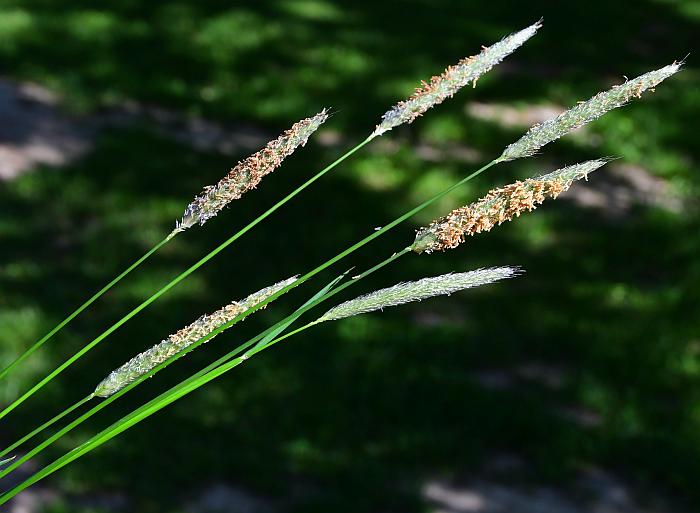Alopecurus pratensis L.
Meadow Foxtail

Introduced
CC = *
CW = -3
MOC = 16
© SRTurner
Alopecurus pratensis L.Meadow Foxtail | |
 |
Introduced CC = * CW = -3 MOC = 16 |
© SRTurner |
|
Family - Poaceae/Aveneae Habit - Perennial cool-season (C3) grass, forming small clumps. Stems - Flowering stems 40-90 cm long, erect or ascending from often spreading bases, sometimes rooting at the lower nodes.
Leaves - Leaf sheaths with the ligules 1-4 mm long. Leaf blades 4-25 cm long, 2-8 mm wide, flat.
Inflorescences - appearing as dense, cylindrical spikes, the short branches appressed to but not fused with the main axis, not apparent at flowering time without dissecting the inflorescence. Inflorescences 2-10 cm long, 5-11 mm wide. Glumes 3.5-6.0 mm long, sharply pointed at the tip, hairy, especially along the midnerve (keel) and lateral nerves.
Spikelets - Strongly flattened laterally, disarticulating below the glumes, with 1 perfect floret and without additional staminate or sterile florets. Glumes about as long as the lemma, similar in size and shape, oblong to elliptic-ovate, rounded to sharply pointed at the tip, awnless, usually fused toward the base, strongly keeled and 3-nerved, hairy, at least on the midnerve (keel). Lemma thin and membranous, oblong-elliptic, rounded to sharply pointed at the tip, faintly 3-or 5-nerved, glabrous, with a slender awn 5-10 mm long (extended 2-6 mm past the glumes), attached toward the base of the lemma midnerve, twisted or bent abruptly near the midpoint. Palea absent. Stamens 3, the anthers 1.6-3.5 mm long.
Fruits - Caryopses 1.5-3.0 mm long. Flowering - May - August. Habitat - Pastures, fields, roadsides, moist disturbed grassy areas. Origin - Native to Eurasia. Lookalikes - Other members of the genus, also Phleum pratense. Other info. - This grass species is found in grasslands across much of the continental U.S., especially in the Northwest, though it is still not terribly common in Missouri. From a few feet away it strongly resembles Phleum pratense (timothy), both of which are grown for hay. It is easily distinguished from timothy by a close look at the inflorescence. Spikelets of timothy have a distinctive "horned" appearance, whereas those of Alopecurus are simply tapered to a single sharp point at their apex. Another characteristic feature of this plant is that the relatively soft awns attach near the base of the lemmas. Photographs taken near Labadie, Franklin County, MO, 4-29-2023 (SRTurner). |